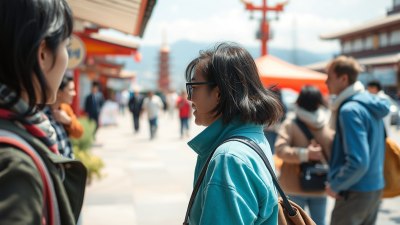Seeing the Familiar Through Foreign Eyes
Explore how different cultures perceive familiar aspects of life through a unique lens.

Image created with Flux Schnell
In a world that is rapidly globalizing, the ability for people from different backgrounds to interact has created a fascinating dynamic. Observing familiar objects or practices through the eyes of someone from another culture can reveal refreshing insights and highlight profound differences. This phenomenon, known as seeing the familiar through foreign eyes, encourages a greater appreciation for cultural diversity and prompts introspection about one's own cultural norms.
When foreigners visit a new land, they often experience a culture shock initially; they encounter things that seem ordinary to locals but carry unique meanings or customs for visitors. For example, consider the act of greeting someone. In the United States, a firm handshake is customary, while in Japan, a bow is more appropriate. Such differences can lead to misunderstandings, yet they also provide a golden opportunity for deeper understanding and connection.
Understanding Cultural Norms
Cultural norms serve as the unwritten rules governing behavior and expectations within a society. These norms can be baffling to outsiders, emphasizing the varied ways people navigate their social environments. For instance, in many Middle Eastern countries, hospitality is a crucial element, where a guest is treated with utmost respect and generosity. Conversely, in some Western cultures, hospitality may be more reserved and based on mutual consent beforehand.
Through the lens of a foreigner, simple acts like sharing food or inviting someone to their home take on new meanings. It becomes clear how cultural background influences interpersonal dynamics and societal structures. This realization can enable individuals from varying cultures to approach each other with more sensitivity and openness.
The Role of Language
Language is another critical aspect through which cultural perceptions are filtered. The saying “lost in translation” resonates deeply when exploring how words carry cultural weight. For example, the untranslatable Japanese word “Kawaii” embodies more than just cuteness; it encapsulates cultural significance tied to innocence and charm. When people from different linguistic backgrounds share their languages, they often uncover layers of meaning, humor, and perspective that would otherwise remain hidden.
Moreover, idiomatic expressions provide a rich tapestry for understanding cultural attitudes. An English speaker might say, “It’s raining cats and dogs” during a heavy downpour, while a Persian speaker would express it as “It’s raining in buckets.” Both phrases evoke vivid imagery but reflect different cultural approaches to describing reality, illustrating how language shapes our worldview.
Art as a Reflection of Culture
Art offers another compelling example of how foreign eyes can reveal new interpretations of the familiar. The way art is perceived varies widely across cultures, dictated by historical context and social commentary. A painting or sculpture that seems benign to an insider may evoke profound emotions or memories in an outsider. For instance, consider the intricate designs of Islamic art; their repetitive patterns can be seen simply as decorative by some, while others recognize them as spiritual representations of infinity.
Furthermore, cultural appropriation occurs when elements of one culture are borrowed by another, often leading to tension or appreciation depending on the context. Engaging with art from a different culture encourages individuals to reevaluate their relationship with their own cultural artifacts as well. This introspective journey can promote understanding and often reveals hidden complexities in seemingly routine cultural expressions.
Traditions and Festivals
Traditions and festivals are vital aspects of cultural expression that illustrate how foreign perspectives can enhance understanding. Take, for example, the Hindu festival of Diwali, which emphasizes the triumph of light over darkness. To those raised in a culture without such celebrations, Diwali may seem like mere festivities. However, a deeper exploration into its symbolism can lead to insights about resilience, hope, and the significance of community during challenging times.
Similarly, during Lunar New Year, the concept of family reunion and ancestral homage may be perceived differently by various cultural lenses, with each tradition carrying layered meanings. Understanding what these festivals represent to their respective cultures can lead to astounding revelations about the values, hopes, and fears of those who celebrate them.
Food and Culinary Experiences
Food serves as a window into a culture’s character and values as well. The way a dish is prepared, shared, and consumed can greatly differ, highlighting cultural attitudes towards food and consumption. For instance, communal eating practices in Ethiopian culture, where diners share from a communal platter, contrast starkly with Western dining norms, which often emphasize individual plates.
Through the eyes of a foreigner, familiar foods may be reinterpreted. An American might find the combination of sweet and savory in dishes from Southeast Asia perplexing, illustrating how taste preferences are culturally constructed. Additionally, cooking techniques and ingredient choices convey historical narratives, connecting people to their ancestry and regional abundance.
Challenges of Perspective
While seeing the familiar through foreign eyes brings positive insights, it is not without challenges. Misinterpretations can arise from preconceived notions or stereotypes. For example, a visitor might expect a culture to be homogeneous and thus overlook the nuances and diversities present within that culture itself. This can lead to generalizations that negate individual differences and the richness of cultural identities.
Critical thinking becomes crucial in these instances. Individuals must engage with foreign perspectives while acknowledging their biases. The art of active listening, genuine curiosity, and a willingness to learn can bridge the gap between cultures, allowing for meaningful dialogue and understanding.
The Impact of Globalization
In an age of globalization, the blending of cultures leads to shared experiences and collaborative learning. New intersections create opportunities for cultural exchange, enabling people to appreciate diverse traditions and viewpoints. However, this globalization can also lead to the dilution of cultural practices, creating a homogenized world. It’s imperative to remember that while similarities may exist, distinct cultural identities are foundational to our human experience.
How people see the familiar through foreign eyes can vary greatly depending on individual backgrounds and experiences. One person's everyday life can become a wonder to someone else. As we embrace this perspective, it’s crucial to maintain a balance, valuing both the commonalities and differences that make cultures unique.
Personal Growth Through Exposure
Engaging with diverse cultures broadens one’s horizons and prompts personal growth. Exposure to different ways of life can challenge one’s beliefs, introduce varying philosophies, and stimulate creative thinking. This psychic expansion allows individuals to navigate an increasingly interconnected world with empathy and understanding. Through shared experiences, people can develop a sense of belonging that transcends geographic boundaries.
Traveling and interacting with diverse cultures can also instill a sense of gratitude for one’s own culture and privileges. Understanding how people approach life in different ways highlights the complexities of happiness, success, and fulfillment, urging one to evaluate what they hold dear through a new lens.
Promoting Inclusivity
Ultimately, learning to see the familiar through foreign eyes fosters inclusivity and acceptance. It highlights the beauty in diversity, crafting a world where individuals from varying backgrounds coexist and thrive together. Encouraging conversations about cultural perceptions can lead to a more harmonious society wherein individuals appreciate their differences instead of fearing them.
Efforts to create inclusive environments in workplaces, schools, and communities can harness the advantages of cultural diversity. Such initiatives have the potential to cultivate innovative ideas, drive collaboration, and enhance social cohesion. By advocating for representation and understanding in all spheres of life, societies can enrich their collective narrative.
Seeing the familiar through foreign eyes holds an essential place in cultural exploration and understanding. By paying attention to how practices, language, art, and traditions are perceived differently, we can learn to appreciate both the universal experiences that unite us as human beings and the particularities that define our individual cultures. Each perspective adds another layer to the rich tapestry of human existence, teaching us to engage with the world around us with curiosity, empathy, and respect.











